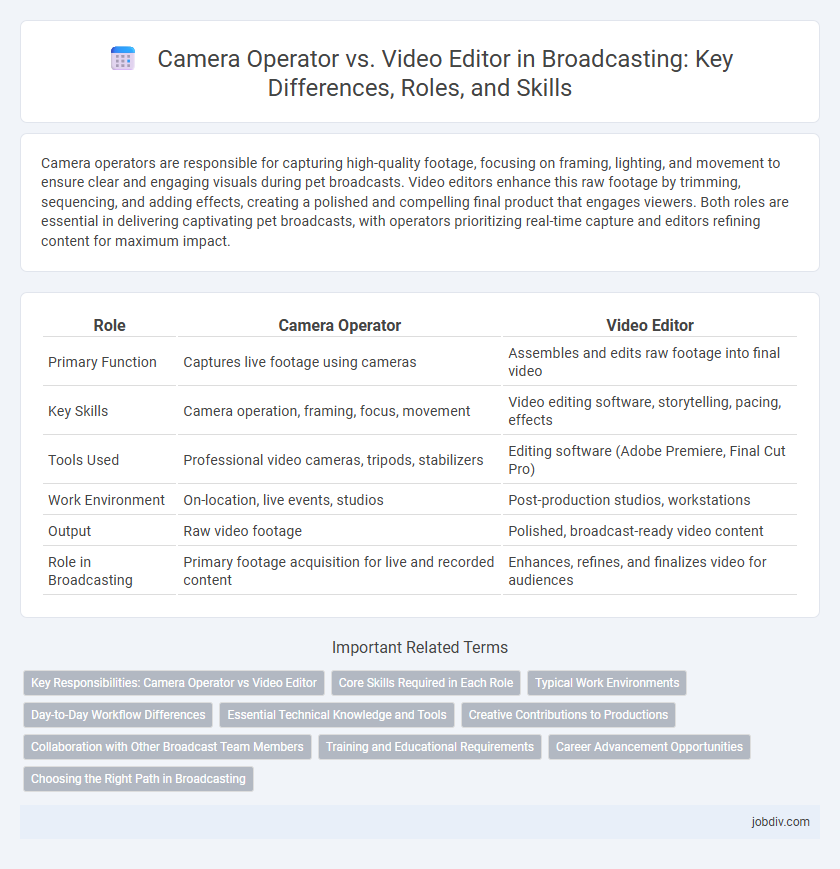Camera operators are responsible for capturing high-quality footage, focusing on framing, lighting, and movement to ensure clear and engaging visuals during pet broadcasts. Video editors enhance this raw footage by trimming, sequencing, and adding effects, creating a polished and compelling final product that engages viewers. Both roles are essential in delivering captivating pet broadcasts, with operators prioritizing real-time capture and editors refining content for maximum impact.
Table of Comparison
| Role | Camera Operator | Video Editor |
|---|---|---|
| Primary Function | Captures live footage using cameras | Assembles and edits raw footage into final video |
| Key Skills | Camera operation, framing, focus, movement | Video editing software, storytelling, pacing, effects |
| Tools Used | Professional video cameras, tripods, stabilizers | Editing software (Adobe Premiere, Final Cut Pro) |
| Work Environment | On-location, live events, studios | Post-production studios, workstations |
| Output | Raw video footage | Polished, broadcast-ready video content |
| Role in Broadcasting | Primary footage acquisition for live and recorded content | Enhances, refines, and finalizes video for audiences |
Key Responsibilities: Camera Operator vs Video Editor
Camera operators are responsible for capturing live footage by managing camera equipment, framing shots, adjusting focus, and following director instructions to ensure visually appealing content. Video editors handle post-production tasks like assembling raw footage, syncing audio, adding effects, and color grading to create a polished final product. Both roles require technical proficiency but emphasize distinct stages of the broadcasting process--camera operators work on set during shooting, while video editors refine content in post-production.
Core Skills Required in Each Role
Camera operators require expertise in framing, focus control, and movement coordination to capture high-quality footage under varying shooting conditions. Video editors must master software proficiency, storytelling techniques, and color grading to craft coherent, visually compelling narratives. Both roles demand strong attention to detail and an understanding of broadcast standards to ensure professional production quality.
Typical Work Environments
Camera operators typically work on location shoots, such as outdoor events, studios, or live broadcasts, requiring adaptability to various lighting and environmental conditions. Video editors primarily operate in post-production studios or editing suites, utilizing advanced software to refine footage and enhance visual storytelling. Both roles demand collaboration with production teams but differ significantly in workspace dynamics and technical environments.
Day-to-Day Workflow Differences
Camera operators capture live footage by managing framing, movement, and focus during broadcasts, requiring quick adjustments and real-time decision-making on set. Video editors work post-production to assemble, trim, and enhance recorded content, ensuring smooth transitions, color correction, and audio synchronization for a polished final product. While camera operators emphasize real-time execution and technical camera skills, video editors specialize in software proficiency and narrative pacing within editing suites.
Essential Technical Knowledge and Tools
Camera operators must master camera settings such as aperture, shutter speed, and ISO to capture high-quality footage, using tools like tripods, sliders, and gimbals for stability and smooth movement. Video editors require proficiency in software like Adobe Premiere Pro, Final Cut Pro, and DaVinci Resolve to assemble, color-correct, and enhance video content. Both roles demand an understanding of frame rates, resolution standards, and audio sync to ensure seamless production quality in broadcasting.
Creative Contributions to Productions
Camera operators capture live footage and frame shots that set the visual tone and storytelling pace, directly influencing the production's aesthetic and emotional impact. Video editors shape the narrative by selecting, sequencing, and enhancing raw footage, adding effects and sound design to create a cohesive and engaging final product. Both roles are essential creative contributors, with camera operators providing the visual foundation and video editors refining and amplifying the story's message.
Collaboration with Other Broadcast Team Members
Camera operators and video editors collaborate closely with directors, producers, and audio technicians to ensure seamless live broadcasts and polished post-production content. Camera operators capture raw footage based on real-time cues, while video editors refine this material to meet creative and technical standards. Effective communication and synchronized workflows between these roles optimize storytelling and broadcast quality.
Training and Educational Requirements
Camera operators require hands-on training in camera techniques, composition, and equipment handling, often gained through specialized courses or vocational programs in broadcasting or film production. Video editors need proficiency in editing software such as Adobe Premiere Pro or Final Cut Pro, typically acquired through formal education in digital media, film studies, or dedicated editing workshops. Both roles benefit from internships and practical experience to develop technical skills and industry knowledge essential for broadcasting success.
Career Advancement Opportunities
Camera operators gain career advancement opportunities by mastering complex equipment and live production techniques, leading to roles like director of photography or broadcast engineer. Video editors enhance their resumes through proficiency in advanced editing software and storytelling, paving the way for positions such as senior editor or post-production supervisor. Both career paths offer growth in specialized technical skills, creative leadership, and involvement in high-profile broadcasting projects.
Choosing the Right Path in Broadcasting
Camera operators capture live footage with a focus on framing, movement, and lighting, ensuring high-quality raw visuals essential for any broadcast production. Video editors transform these visuals by assembling, color grading, and adding effects to create a seamless narrative that aligns with the show's style and pacing. Choosing the right path depends on whether you prefer on-the-spot creativity behind the lens or detailed post-production craftsmanship in storytelling.
Camera Operator vs Video Editor Infographic

 jobdiv.com
jobdiv.com